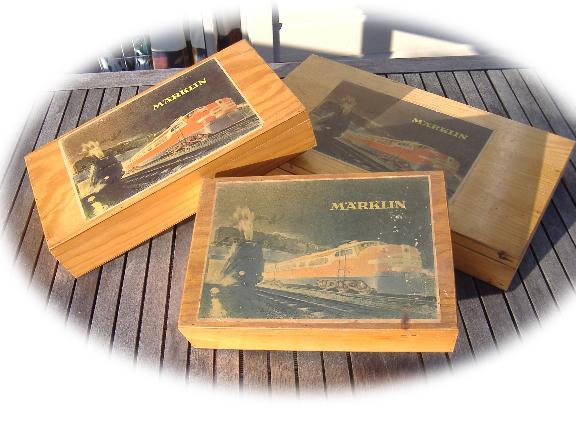The Mysterious Märklin Wooden Boxes
(© Article by Stephen Cook - 2011)
Apparently unique to New Zealand, several well-made wooden boxes, all individually numbered and in several sizes have intrigued myself and others for a number of years.
This to me has been an ongoing mystery and concerns a number of apparently genuine Märklin wooden storage boxes found over the past few years around N.Z.
The first one came to me around the late 1980's from a retail store in Auckland (Stokers of Greenlane) who was once a big-time Märklin dealer. It was an interesting-looking box but it gave absolutely no clues to its original purpose. It came to me along with an original Märklin Signal-Testing device (40499) so at the time I believed the box to also be ex-factory, in part because of its design, the good construction, the distinctive label attached to the lid, plus its provenance from a reputable dealer.
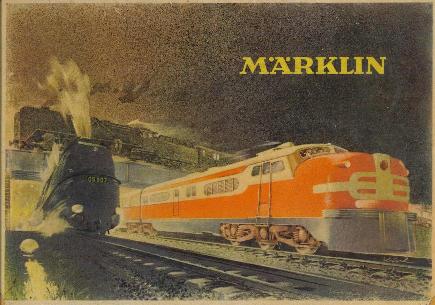
It was several years before the next one came to my attention when one was acquired by the Marklin Model Railway Club Inc (MMRC) for the Museum. Then a fellow enthusiast Allan Grant told me he had one, then another appeared. By 2003 I had taken notice and started comparing and asking questions.
CONSTRUCTION
The boxes were all identical, except for two specific details.
1: There were a range of different sizes, 5 sizes confirmed so far (see image at top for comparison of three of the sizes)
2: Each box was individually numbered inside the box and the lid (same number in both)
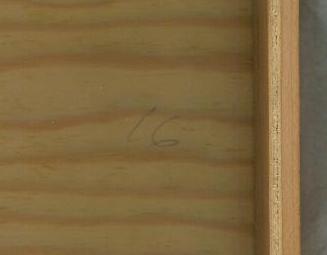
Other than this however, the design and construction was identical, and the picture label was the same.
The boxes are fairly lightweight, the timber almost certainly Pine, and they are varnished on the outside. Looking carefully at the grain on the outside, it follows from the base through to the lid and this is probably what accounts for the numbering to ensure the correct lid is with the matched base, as both would have been made from the same sheet or section of timber. See example here of the timber grain running perfectly through the join with matching lid and base (slightly blurry sorry)
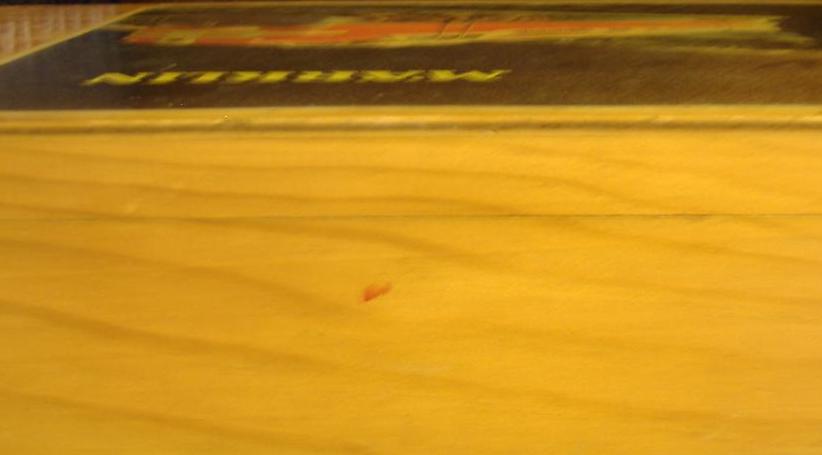
But, the questions remained:
A: What period did they date from?
B: What was their original purpose?
The period could be established somewhat approximately from the image label as belonging to around 1950. I have since found examples of the red-box sets with the exact same label so I knew the label to be genuine at least. Example below (this is set TM 865/4, only available 1950 & 1951)....
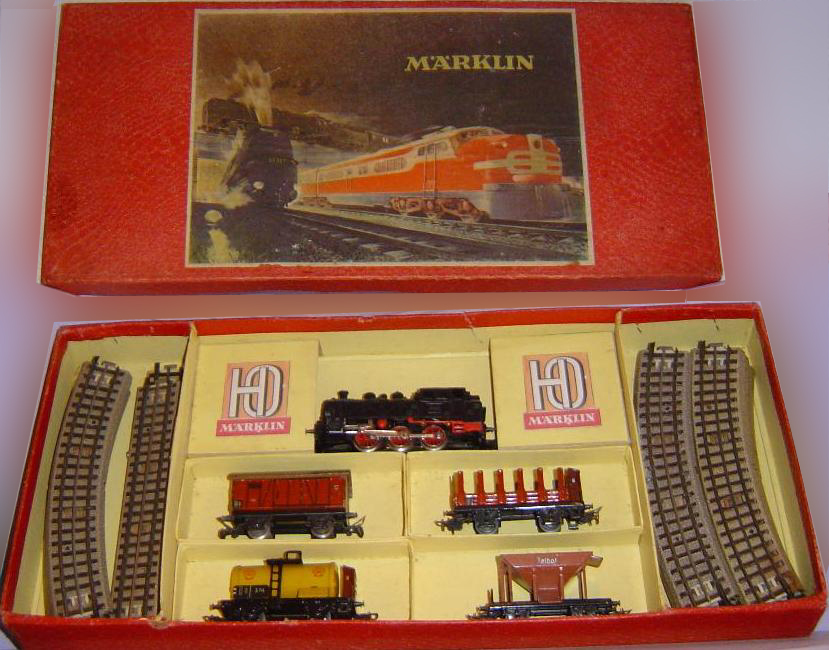
Asking around I started finding other people who also had one or more of these boxes. At least a couple of those people are serious and respected long-time Marklineers who "know their stuff". The prevailing view was that these boxes originally contained Starter Sets, with some alternative suggestions that they may have been parts or accessory boxes.
But the most interesting detail of all was that not a single one was known to exist outside of New Zealand. Not even in NZ's nearest neighbour Australia. Previous checks by other NZ collectors with trusted collectors in Germany etc all came up blank - no one had seen them.
Then out of the blue in October 2006, one appeared on our NZ leading auction site (trademe), followed shortly after by another, and then one more. Yikes, an epidemic was unfolding and so the search began in earnest to find the origin and purpose of these boxes.
My first step was to document all the examples I knew to exist and so far I have personally seen or confirmed reliably the existence of sixteen (16) of these boxes in various sizes and pencilled numbers on the inside. The following dimensions are in mm & rounded off to nearest 5mm.
|
Length x Width x Depth 340 x 230 x 80 (4 examples) |
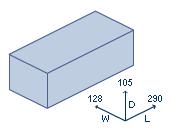 |
In two cases, the owners of the boxes recalled without any doubt that they contained a starter set. Most of the rest had no history of the box although three of them are with a smaller Wellington retailer (Train Technology) who use them for spare parts and I believe had obtained them from a larger retailer (Smiths Cycles).
An obvious avenue to check was Märklin themselves. This was their response (Feb 2010 by email)...
"Dear Mr. Cook,
We are sorry but only one part on your photos seems to be an original Märklin product. It is the red cover of a starter package on the 3rd. Photo. The wooden boxes are not from us.
Sincerely yours,
Your Maerklin Customer Service"
At the same time that I contacted Märklin Service, I also contacted the NZ Forestry Research Inst. regarding how to tell where a particular sample of wood could be traced to. A couple of detailed photos were sent off to them and the response is as follows....
"Thanks Stephen. Based on your information and the images, the wood is very likely to be radiata pine from NZ. Wood from Germany would be Nordic pine or spruce both of which would have very narrow growth rings. From your images I see 1-2 cm growth rings typical of radiata pine.
If you want me to confirm this it would be preferable to send the box which of course I will return to you after examination. I will be discrete about taking any samples to avoid any obvious damage."
So once again, a fairly conclusive response. At this point I'm happy to accept that the boxes were made in NZ, for purposes yet to be fully confirmed. Analysis could be done, but at around $80 for that test, I'm happy with the verbal explanation.
THE LABELS?
So the boxes did not originate in Germany, but the attached labels almost certainly did. The labels alone are quite notable, bearing in mind when they were produced, roughly in the period circa 1950-1955. The labels on both the NZ timber and factory-cardboard boxes are A4-size and appear identical in every respect. These would have been expensive to reproduce with the technology of the time. And it's not like you could have just popped down to your local copy shop and had some printed up.
These labels were the one aspect that had many people assuming they were of factory origin. Turning my thinking to those, we already have confirmation from Märklin that they consider them to be genuine. Of course they could be copies/reproductions, but this would require the use of printing processes that would simply appear to have been uneconomic for the period of production and volume printed. I turned to my good friend Rex Trye, a fellow Märklin enthusiast of many years, and co-incidentaly, a Printer by Trade. His thoughts are....
"This artwork would require four colour printing. Which at that time Photo Litho was expensive, requiring four photographic negatives. For a print run of 100 just not worth it.
Letter press more common, yet again four plates required. Again for a print run of 100 just not worth it.
My conclusion it's original Marklin supplied art work."
Ok, so pending any further input, we shall assume the boxes were made in NZ, and decorated with original artwork labels supplied by (and one assumes with the blessing of) Märklin. One single box of mine actually has two labels, one on the top of the lid, and one on the underside of the box.
PS; And while we are on the subject of the labels, HERE'S A PUZZLE FOR THE OBSERVANT; I made a very interesting observation within the image (below) while studying them. A small detail that has stumped everyone so far (including myself) - it's obvious, but not so obvious....
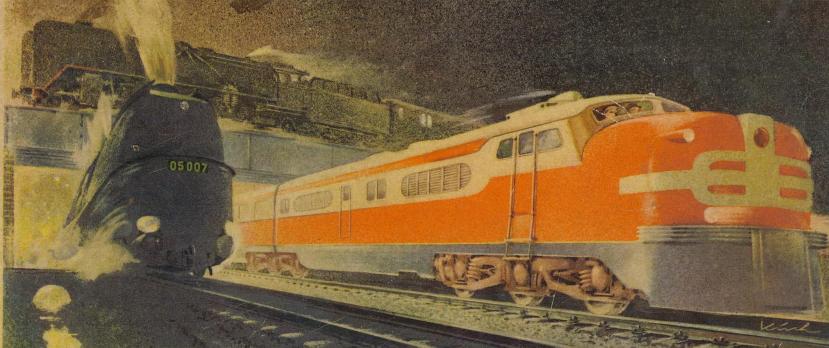
.... are you willing to venture a guess what it is? (email me - see bottom of page)
QUANTITY AND NUMBERING?
As mentioned above, all but two or three of the 16 boxes are individually numbered, in pencil, in the box and the lid, and most of the boxes have matching numbered lids and boxes. But what about these numbers?, well here's another interesting point. There are at least two different sized boxes each with matching number "22", plus a further largest size box also with the lid numbered 22, .
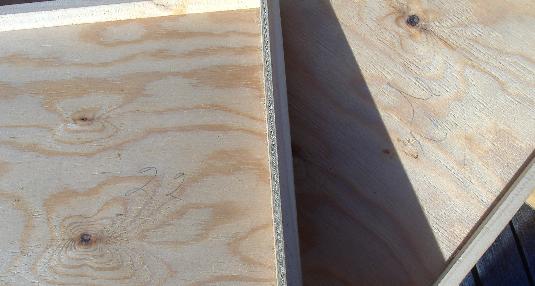
The lowest numbered box found is No. "7", the highest is either "42" or "47" (the owner Jan Kasprzyk has found it quite hard to read). Because at least one sequence number has been noted in three of the sizes, I suggest it's safe to assume that each box/lid series started numbering from #1. And so far we have confirmed at least FIVE different sizes. The smallest size (340 x 225 x 80) gets up to above #40 (either 42 or 47). Allan Grant's Box (420 x 225 x 80) is numbered 31. One of my own boxes (510 x 300 x 75) is number "34" (although on this one the lid is "22").
Based purely on the numbering I'll take the assumption that at least 20 of each box size were made, possibly many more. That's still over 100 of these boxes, of which 16 are verified. So who's got others? It's not the kind of box that would get thrown away, it's too attractive and too useful for holding any manner of things, Märklin or otherwise. I hope a few more of them will come to light as a result of this article.
ORIGINAL PURPOSE FOR THE BOXES?
As best I can determine, in the early 1950's the Märklin Agent for New Zealand and Australia was H W Clarke (NZ) Ltd. H.W.C were taken over in the late 60's or very early 70's by EMAIL Industries and at that time, Hank Edwards was running the Märklin division which also handled FALLER model kits, plus some other Hobby & Toy agencies, Dolls etc.
Now I am no expert in this area so please allow some leeway here but for many years, NZ had a system of quite high import tarrifs on imported goods. People wanting to import from overseas had to purchase overseas funds in advance and apply for a license to import the goods. I also believe different rates were imposed on items if they were a complete item, or in component form. A good example being imported cars. A CBU (completely-built-up) attracted a higher customs tarrif or import duty than the same individual components of that same car, if assembled by a local company using local labour.
In a similar manner, I have wondered whether 'luxury' items such as toy trains may have had a different rate applied to them for a complete boxed set, vs. the same individual components (Engines, Rolling-stock, Track, accessories) imported as loose items, and re packed locally back into complete sets? This customs theory is nothing more than that however, and it could be way off the mark.
BOXED STARTER SETS?
This is one possible explanation for the manufacture of these relatively sturdy and attractive wooden boxes. The importer could then sell complete sets, more profitably (or even at all if complete sets were somehow restricted), AND, that importer would almost certainly have had the blessing of the Märklin factory because it meant sales of more products. This could account for Märklin supplying sufficient original labels to be attached to the boxes for presentation in a retail store. It is also possible that the importer simply wanted to sell boxed sets but calculated that he could assemble them from the component items at lower cost than importing them complete?
There are so far two trusted and verifiable instances of these boxes being used for this purpose. One is a personal recollection of Brian Poulsen who is a long-time member of the Marklin Model Railway Club. Brian also has the rare honour of having worked for one of the larger Wellington retailers, "The Lamphouse" which was a member of the Cornish Group of companies. Brian tells his own story.....
Hi Steve, well done. Just to add to what you have said, I started work in 1956 and by then my first layout was on a board and operating. Cannot say for sure but I think I got the CE 800 and two green carriages 327/1 plus one red carriage 327/2. The CE800 was released in 1953, and I would have got mine for my birthday in 1954, maybe '55. Being released in Germany in 1953 it most likely would not have reached NZ until at least 1954. Circumstances suggest 1955 being most likely, the other interesting point is that as far as I have been able to discover the red carriage was released in Germany only with the wind up set {Ed: S870}, which suggests locals packing the sets would not know this and would think it would look good as a set. As far as I can remember the loco and carriages were packed in the standard individual boxes with corrugated cardboard around track. Transformer came in its own box separately. regards Brian.
The second instance comes from Allan Grant, a long-time and well-respected NZ collector from Christchurch. Allan already had one of these boxes and he then obtained via Trademe the only known instance (so far) of one of these boxes apparently complete, labelled and with the original contents. See images below... (Allan will try for some improved images in due course - these are from the original auction)
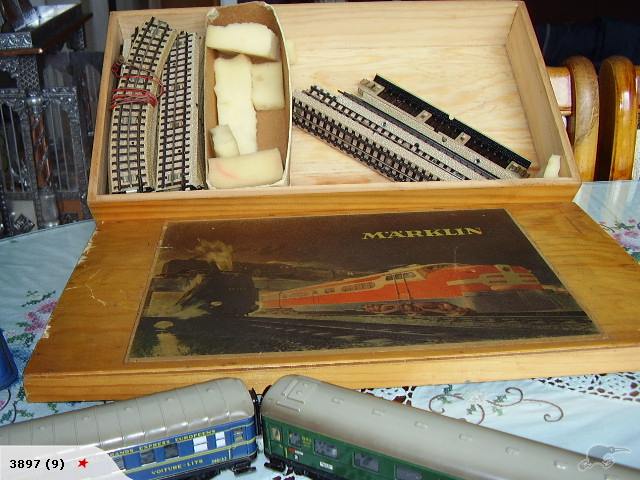 |
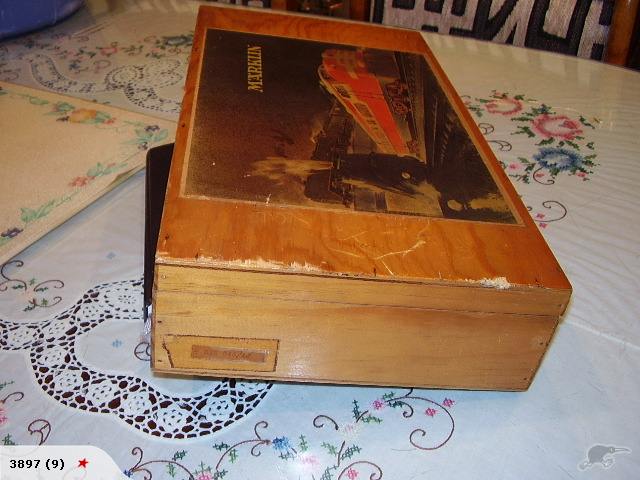 |
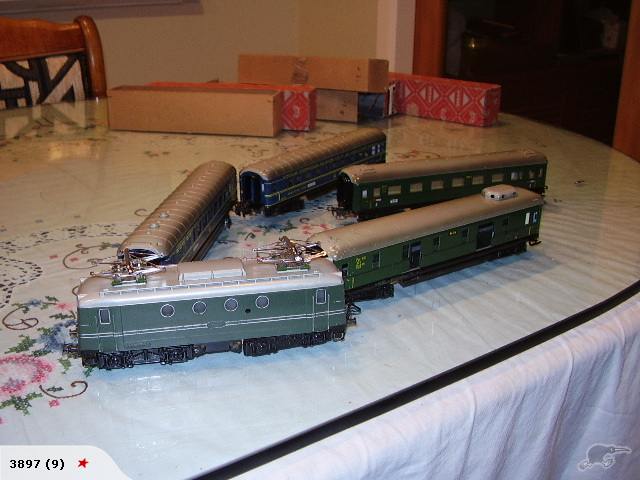 |
There are a couple of interesting points here. The first is that the box carries a label sellotaped to one end marked "SEW846/4J", and that in the original listing details, the seller (who was himself selling it on behalf) stated that the owner had possessed it since 1958, but whether that was from new is unknown. The second point is that specific starter set SEW846/4 J only appears in the 1953 catalogue, and as SEW846/4 JH in 1952. I have not been able to find any specific distinction for the "H" in 1952, both sets appear identical from the catalogue descriptions.
Allan Grant has confirmed that all the contents shown do fit (somewhat snugly) into the box and you will note that unlike the factory set boxes, the coaches have their own individual boxes but not the Loco. Naturally some 'assumptions' are being made here as there is no way to confirm how the contents may have been altered in the intervening years. But it's a starting point at least.
John Paddy has also advised me regarding his box (510 x 300 x 75). John has previously confirmed that his carries a label stating "F846/4 and interestingly also states a price of £31-12-0". John acquired just the box with no contents, but the label and price is worthy of note.
As it turns out, I just happen to have some original NZ price lists from that era and the prices listed for set F 846/4 are as follows....
|
1953 price for 1952 catalogue |
£33-10-0 |
| 1954 price for 1953 catalogue | £28-7-0 |
| 1955 price for 1954 catalogue | £28-7-0 |
| 1956 price for 1955 catalogue | TBC |
| 1957 price for 1956 catalogue (new item set number 3018) | £25-15-0 |
This table would tend to indicate John's box and price as being from around 1952/53, or that the retailer was not strictly adhering to the price list but the 1953 price here is closest to what is on the box.
Here is a snip of the actual F 846/4 H description from the 1953 price list...

Link to the full first page above of the 1953 price list - (image is too large to include in this article, use your browser 'back' button to return to this page after viewing)
** with many thanks to John Paddy also for the kind loan of this original pricelist so that I could scan it.
Since starting this article, I have had a further response from one of the MMRC members Jan who has three of these boxes. Jan rechecked his boxes and surprisingly found one of them (the smallest 340 x 225 x 80), still had a small label attached at one corner confirming the original equivalent contents of starter set TM 808/3H.
This particular set appears ONLY in the 1952 catalogue comprising of Loco TM 800, plus three freight wagons, 305, 307/2 & 308 plus the track. It's fantastic that this label has survived on this box and gives pretty solid evidence that the boxes were for locally repackaged Starter Sets and indicates their time of use very closely to around about 1952 and maybe 1 or 2 years after. Another snip from the price list also details this item;

And finally, below are two images to give a comparison of sizes, in the first I have put the lid of one of the boxes alongside a red-box starter set lid, and in the other image, I have placed the contents of SJ set 3118 into the smallest of the boxes such as a similar set might have been packed. (In hindsight, contents of this size would likely have gone into one of the larger boxes with the smaller boxes used for smaller passenger and freight wagons such as Brian's set referred to above).
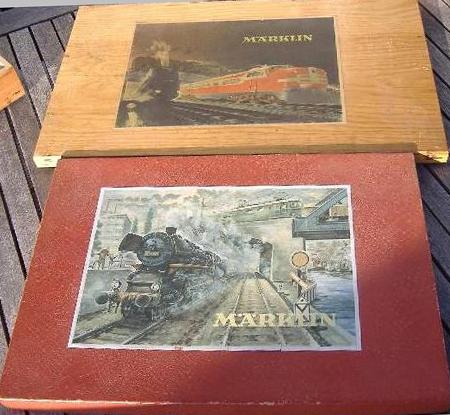 |
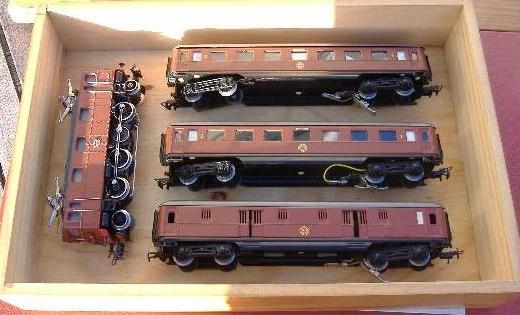 |
Well, thank you for reading this far, you've done well. As of the time of the latest update in May 2011, this is as far as my research has come. But apart from a few knowledgeable friends in the hobby, this story has till now been untold. I am very hopeful that as I tell others, and with possible future publication in the MMRC monthly newsletter, a wider audience will be found and other examples may come to light.
Naturally, if you have one of these boxes, I would love to hear from you with your story, when and how you obtained it, what (if anything) was inside it, and of course some pictures along with your dimensions, and the pencilled number inside the lid and base.
I will add here that there is at least one mismatched box, which I have. It's the very first box I obtained from John at Stokers, and which started off this whole mystery. Exact dimensions are 338 x 227 x 80, Lid numbered '34', Box numbered '22', so somewhere (possibly near Auckland), someone may have the opposite matching pair.
VALUE?
What are (or should) these boxes be worth? As a box they are attractive and useful. We can assume they do not originate from the Factory. But they all carry the authentic label which (until proven otherwise) does originate from the factory and to all intents and purposes, these appear to have been supplied legitimately.
The small number of empty boxes that have changed hands in NZ have done so for between $50.00 - $100 ($NZ), which is not really a large amount. What one might fetch on the international market is quite another matter. They appear to be absolutely unique to NZ and this possibly limits their appeal. One complete with originally packed contents, particularly such as Brian's with a rare Red 327/2 coach might make it very unusual. Allan's SEW846 set has strong value just in the items themselves even without the box. But many Märklin collectors are purists to the extreme. If it did not leave the factory in this format then it's not the 'real deal'.
If one were to come onto Ebay for example it would be very interesting to watch, I'm not yet ready however to sacrifice one of my own to this experiment!!
FEEDBACK AND ACKNOWLEDGEMENTS
I hope you have found this to be interesting and would love your comments and feedback. If you have any difficulty with the way this page displays, please let me know. I have tested it in IE and Google Chrome and it displays correctly in both. My html coding is minimal to keep it small and simple and as with all my pages, my aim is Content and Simplicity. Other people do the frilly stuff much better than me :-)
If I have made any errors that might seem obvious to others, let me know, I'll be happy to correct and acknowledge.
I am very grateful for the assistance, images, and information kindly contributed by the following:
Allan Grant, Brian Poulsen, Derek Townsend, Rex Trye, Peter Lemmon, Ian Barrett, Tim Fairhall, John Paddy, Phil Fedorenko, Jan Kasprzyk, William Deardorff, Brian Teviotdale. Thanks also to Lloyd Donaldson (Scion) re the timber identification.
You can EMAIL me at...: cookee(underscore)nz@yahoo(dot)com (I'm sure you can figure it out - please fight the spam!!)
